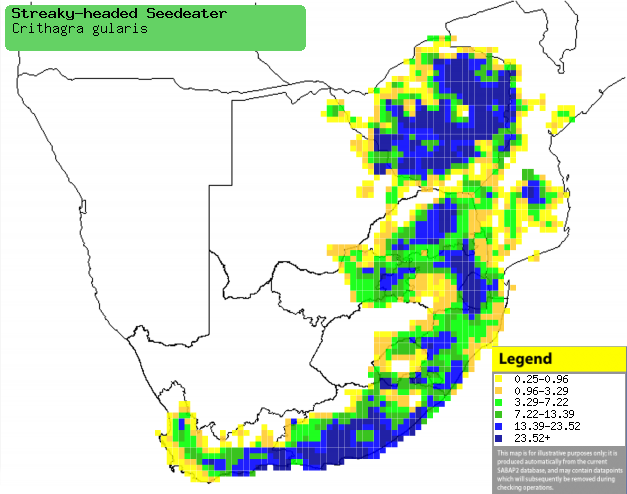|
Crithagra gularis (Streaky-headed
seedeater, Streaky-headed canary)
[= Serinus gularis]
Streepkopkanarie [Afrikaans]; Indweza (also applied to Brimstone
canary) [Xhosa]; umBhalane, umDendeliswe [Zulu]; Toere (generic term for
canaries and siskins) [South Sotho]; Streepkopkanarie [Dutch]; Serin gris
[French]; Brauengirlitz [German]; Canário-de-cabeça-estriada [Portuguese]
Life
> Eukaryotes >
Opisthokonta
> Metazoa (animals) >
Bilateria >
Deuterostomia > Chordata >
Craniata > Vertebrata (vertebrates) > Gnathostomata (jawed
vertebrates) > Teleostomi (teleost fish) > Osteichthyes (bony fish) > Class:
Sarcopterygii (lobe-finned
fish) > Stegocephalia (terrestrial
vertebrates) > Tetrapoda
(four-legged vertebrates) > Reptiliomorpha > Amniota >
Reptilia (reptiles) >
Romeriida > Diapsida > Archosauromorpha > Archosauria >
Dinosauria
(dinosaurs) > Saurischia > Theropoda (bipedal predatory dinosaurs) >
Coelurosauria > Maniraptora > Aves
(birds) >
Order: Passeriformes > Family: Fringillidae
Distribution and habitat
Although it has an isolated population in Angola, it mainly
occurs in southern Africa from Zimbabwe, eastern Botswana and Mozambique to
South Africa, excluding most of the Northern Cape, Free State and North-West
Province. It generally prefers woodland and plains and hillsides, such as
Acacia, broad-leaved and dry riverine woodland, also occupy forest edges,
grassy protea scrub and the border between natural vegetation and cultivated
land and gardens.
|
 |
|
Distribution of Streaky-headed seedeater in
southern Africa, based on statistical smoothing of the records from
first SA Bird Atlas Project (©
Animal Demography unit, University of
Cape Town; smoothing by Birgit Erni and Francesca Little). Colours range
from dark blue (most common) through to yellow (least common).
See here for the latest distribution
from the SABAP2. |
Predators and parasites
It has been recorded as host of psocid
parasites.
Movements and migrations
Resident and sedentary, although it may make
local movements in Winter.
Food
It mainly eats flowers, buds, seeds, nectar, fruit and
insects, doing most of its foraging on the ground and in the foliage of forbs,
grasses, shrubs and small trees, often joining mixed-species foraging flocks. The following food items have been recorded
in its diet:
- Plants
- seeds, nectar and flowers of Tecoma capensis (Cape honeysuckle)
- flowers
- marigolds
- peaches
- apricots
- Rumex (sorrels)
- Aloe (buds, anthers and stamens)
- Erythrina latissima (Broad-leaved coral-tree)
- nectar
- Aloe
- A. marlothii (Mountain aloe)
- A. arborescens (Krantz aloe)
- A. castanea (Cat's-tail aloe)
- A. greatheadii (Spotted aloe)
- A. thraskii (Dune aloe)
- Erythrina latissima (Broad-leaved coral-tree)
- seeds
- Aloe ferox (Bitter aloe)
- mistletoes (Loranthaceae)
- Pinus halepensis (alien Aleppo pine)
- pawpaws
- Acacia karroo (Sweet thorn)
- Cassia
- Amaranthus
- Aspalathus
- Chenopodium
- Chironia
- Eriocephalus
- Lampranthus
- Nymania
- fruit
- Euphorbia ingens (Giant euphorbia)
- Lantana camara (alien Cherry-pie)
- Opuntia ficus-indica (Prickly-pear)
- Maytenus (silky-barks)
- Olea (olives)
- Ficus (figs)
- Morus (mulberries
- Insects
Breeding
- Monogamous, solitary or loosely colonial nester, as it sometimes forms
small groups with little if any territoriality.
- The nest is probably built solely by the female, consisting of a cup of
dead leaves, grass, bark, twiglets, dead seedheads, textiles and paper,
lined with fluffy seeds or other plant down. It is typically placed in the
upright or horizontal fork of a bush or tree, among Bitter aloe (Aloe
ferox) leaves or in a cluster of pine cones.
- Egg-laying season is from September-March.
- It lays 2-4 eggs, which are incubated solely by the female for about
12-15 days.
- The chicks are brooded by their mother for the first 5 days or so of
their lives, and are fed by the female with food provided by the male. They
leave the nest at about 17 days old, but they remain dependent on their
parents for food for some time.
Threats
Not threatened.
References
-
Hockey PAR, Dean WRJ and Ryan PG 2005. Roberts
- Birds of southern Africa, VIIth ed. The Trustees of the John Voelcker
Bird Book Fund, Cape Town.
|
